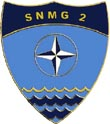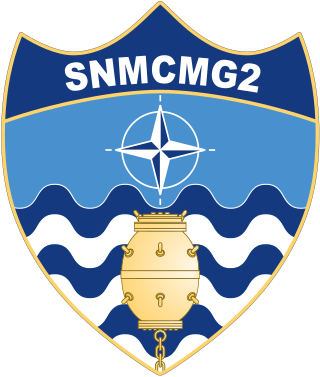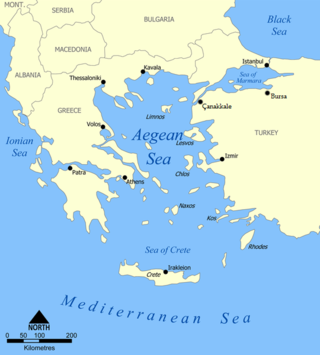
The Sixth Fleet is a numbered fleet of the United States Navy operating as part of United States Naval Forces Europe-Africa. The Sixth Fleet is headquartered at Naval Support Activity Naples, Italy. The officially stated mission of the Sixth Fleet in 2011 is that it "conducts the full range of Maritime Operations and Theater Security Cooperation missions, in concert with coalition, joint, interagency, and other parties, in order to advance security and stability in Europe and Africa." The current commander of the Sixth Fleet is Vice Admiral Thomas E. Ishee.

The Supreme Headquarters Allied Powers Europe (SHAPE) is the military headquarters of the North Atlantic Treaty Organization's (NATO) Allied Command Operations (ACO) that commands all NATO operations worldwide. SHAPE is situated in the village of Casteau, near Mons, Belgium.

Standing NATO Maritime Group One (SNMG1) is one of NATO's standing naval maritime immediate reaction forces. SNMG1 consists of four to six destroyers and frigates. Its role is to provide NATO with an immediate operational response capability.

Standing NATO Maritime Group 2 (SNMG2) is a North Atlantic Treaty Organization (NATO) standing maritime immediate reaction force. SNMG2 consists of four to six destroyers and frigates. Its role is to provide NATO with an immediate operational response capability.

Standing NATO Mine Countermeasures Group 2 (SNMCMG2) is a North Atlantic Treaty Organization (NATO) standing mine countermeasures Immediate Reaction Force. Its role is to provide NATO with an immediate operational response capability.

The United States Naval Forces Europe and Africa (NAVEUR-NAVAF), is the United States Navy component command of the United States European Command and United States Africa Command. Prior to 2020, NAVEUR-NAVAF was previously referred to as United States Naval Forces Europe – Naval Forces Africa and sometimes referred to as United States Naval Forces Europe – Africa.

The Joint Force CommandNaples is a NATO military command based in Lago Patria, in the Metropolitan City of Naples, Italy. It was activated on 15 March 2004, after effectively redesigning its predecessor command, Allied Forces Southern Europe (AFSOUTH), originally formed in 1951. In NATO Military Command Structure terms, AFSOUTH was a "Major Subordinate Command". The commander of JFC Naples reports to the Supreme Allied Commander Europe at the Supreme Headquarters Allied Powers Europe, Casteau, Belgium.

The Allied Joint Force Command Lisbon was one of the largest NATO bases in south Europe Allied Command Operations. It was based in Oeiras, near Lisbon, Portugal. In 2009 a French lieutenant general took command from the previous US Navy admiral who had filled the post for a number of years. It was deactivated in 2012.

Operation Active Endeavour was a maritime operation of the North Atlantic Treaty Organization. It operated in the Mediterranean Sea and was designed to prevent the movement of terrorists or weapons of mass destruction. It had collateral benefits in enhanced security of shipping in general. It was one of the first military actions taken by NATO in response to an invocation of Article 5 of the North Atlantic Treaty which provides for collective defense and the first-ever operation conducted by the Alliance in direct application of the defense clause of the Treaty. In November 2016 it was replaced by the non-Article-5 Operation Sea Guardian.

HNLMS De Ruyter is a De Zeven Provinciën-class frigate of the Royal Netherlands Navy. She was laid down in 2000, launched in 2002, and commissioned in 2004, the third ship of her class to enter service. The frigate is named after Dutch admiral Michiel de Ruyter (1607–1676).

Exercise Grand Slam was an early major naval exercise of the newly formed North Atlantic Treaty Organization (NATO). This 1952 combined naval exercise took place in the Mediterranean Sea, and it included a naval force that was described as being "the largest armada to be assembled in that area since the end of World War II." Exercise Grand Slam was an early test for NATO's Allied Forces Southern Europe. With Exercise Longstep, this exercise served as the prototype for future NATO maritime exercises in the Mediterranean Sea during the Cold War.
The Structure of the North Atlantic Treaty Organization is complex and multi-faceted. The decision-making body is the North Atlantic Council (NAC), and the member state representatives also sit on the Defence Policy and Planning Committee (DPPC) and the Nuclear Planning Group (NPG). Below that the Secretary General of NATO directs the civilian International Staff, that is divided into administrative divisions, offices and other organizations. Also responsible to the NAC, DPPC, and NPG are a host of committees that supervise the various NATO logistics and standardisation agencies.

Operation Unified Protector was a NATO operation in 2011 enforcing United Nations Security Council resolutions 1970 and 1973 concerning the Libyan Civil War and adopted on 26 February and 17 March 2011, respectively. These resolutions imposed sanctions on key members of the Gaddafi government and authorized NATO to implement an arms embargo, a no-fly zone and to use all means necessary, short of foreign occupation, to protect Libyan civilians and civilian populated areas.

Exercise Longstep was a ten-day NATO naval exercise held in the Mediterranean Sea during November 1952 under the overall command of Admiral Robert B. Carney, USN, the Commander-in-Chief Allied Forces Southern Europe (CINCAFSOUTH). This exercise involved over 170 warships and 700 aircraft, and it featured a large-scale amphibious assault along the western coast of Turkey. With Exercise Grand Slam, this exercise served as the prototype for future NATO maritime exercises in the Mediterranean Sea during the Cold War.
Allied Naval Forces Southern Europe (NAVSOUTH) was a Component Command in NATO's Allied Forces Southern Europe (AFSOUTH).

The Allied Maritime Command (MARCOM) is the central command of all NATO maritime forces and the Commander MARCOM is the prime maritime advisor to the Alliance. When directed by the Supreme Allied Commander Europe (SACEUR), it provides the core of the headquarters responsible for the conduct of maritime operations. The command is based at the Northwood Headquarters in Eastbury, Hertfordshire.

Naval Striking and Support Forces NATO (STRIKFORNATO) is a naval command of Allied Command Operations of North Atlantic Treaty Organization (NATO). It is part of the NATO Force Structure. STRIKFORNATO is commanded by the Commander of the United States Sixth Fleet, and it is the only command capable of leading an expanded maritime task force. Its predecessor was Naval Striking and Support Forces Southern Europe (STRIKFORSOUTH); the name change took place in 2004.

Allied Command Channel (ACCHAN) was one of three major North Atlantic Treaty Organization (NATO) commands from 1952 to 1994. Commander-in-Chief Channel was a Major NATO Commander (MNC).

James Gordon Foggo III is a retired United States Navy admiral who last served as commander of United States Naval Forces Europe-Africa and commander of Allied Joint Force Command Naples. He previously served as the director of Navy Staff. Prior to that, he served as the commander of United States Sixth Fleet. He assumed his last assignment on October 20, 2017. On July 17, 2020, he relinquished command of United States Naval Forces Europe-Africa and Allied Joint Forces Command Naples to Admiral Robert P. Burke.

Rear Admiral Robert George Pedre is a senior Royal Navy officer and current Commander United Kingdom Strike Force.


















